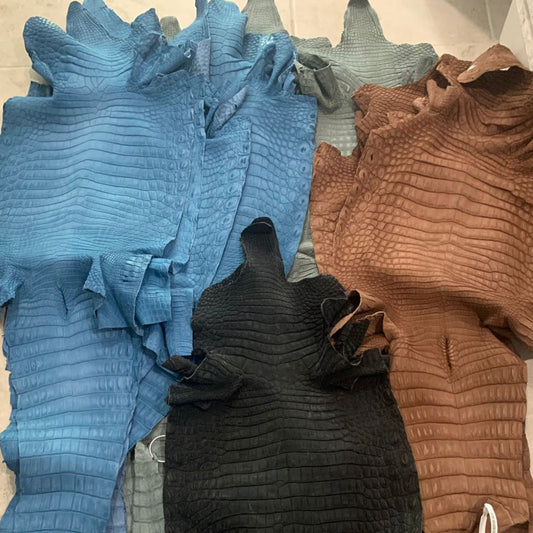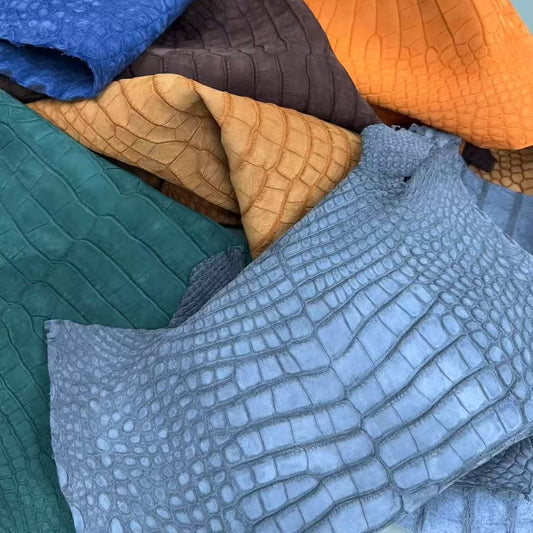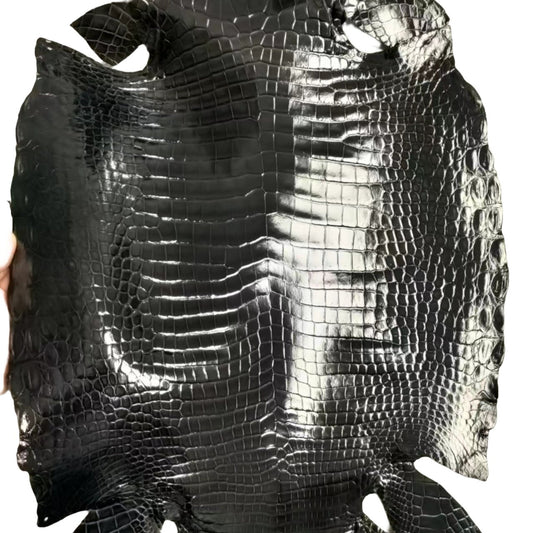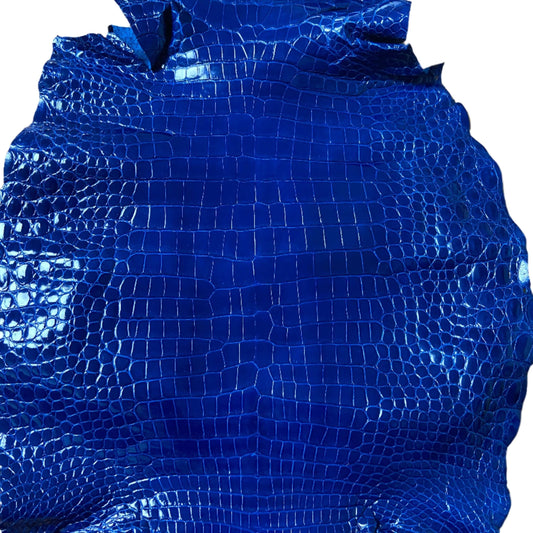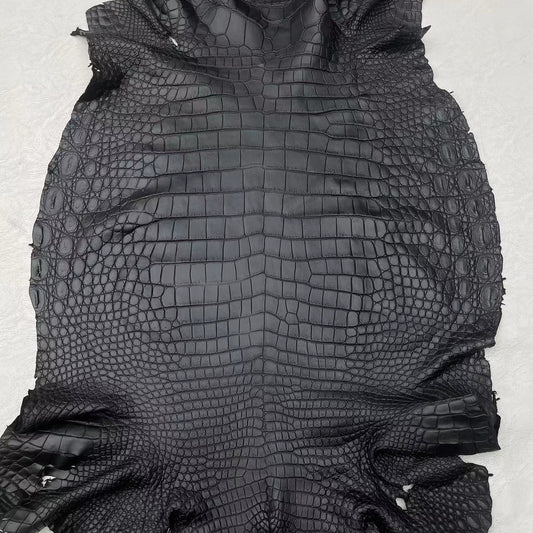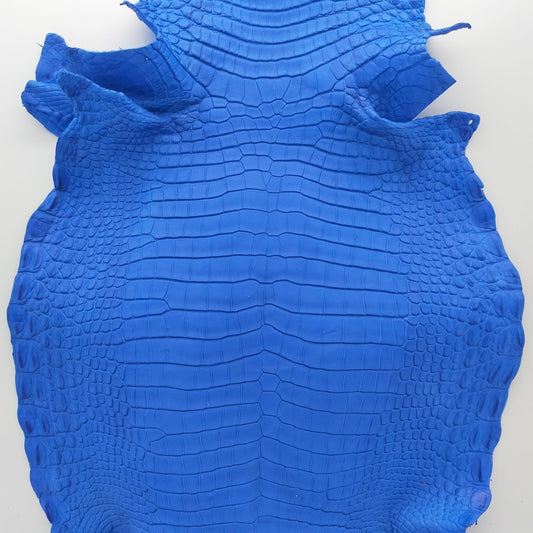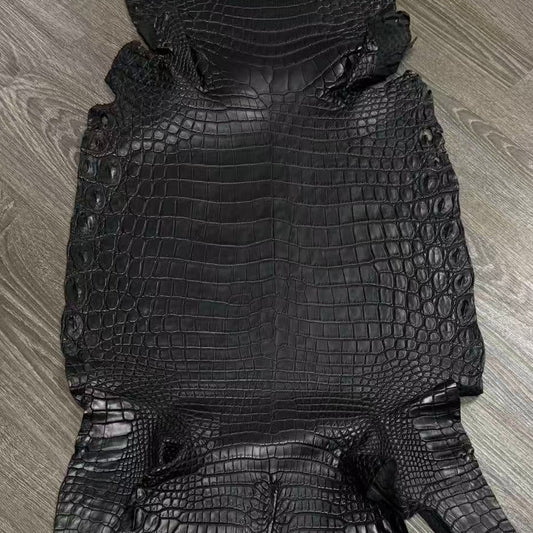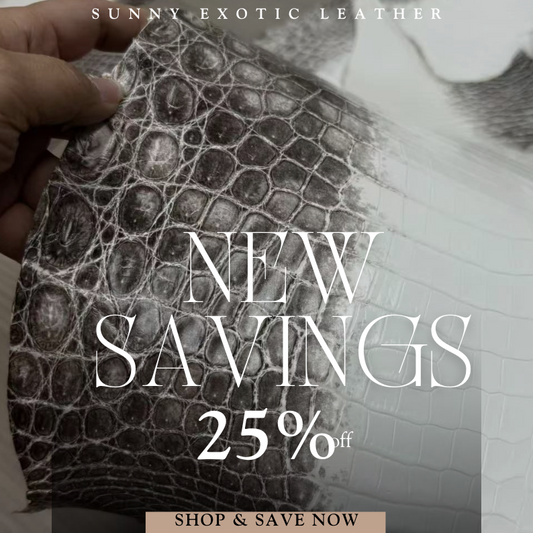Piel de cocodrilo: todo lo que necesitas saber
Compartir
Presentamos pieles de caimán: un material atemporal para tu guardarropa.

La piel de caimán tiene una larga historia de uso para una variedad de artículos y accesorios de cuero de alta gama, incluidos bolsos, calzado, correas de reloj, prendas de vestir, cinturones, billeteras y más. El caimán americano, nativo del sudeste de los EE. UU., es la fuente de estas codiciadas pieles. Estos animales pueden ser capturados en estado salvaje o criados en granjas, con una estricta regulación por parte de la autoridad de Pesca y Vida Silvestre de cada estado para garantizar prácticas sustentables.
Durante siglos, las pieles de caimán se han cosechado por su durabilidad y belleza. A principios del siglo XIX, las pieles de caimán se utilizaban para fabricar botas, zapatos y sillas de montar, y para fabricar aceite que se utilizaba para engrasar las máquinas de vapor y las fábricas de algodón. Tras el descubrimiento de los procesos de curtido comerciales a finales del siglo XIX y principios del XX, el cuero de caimán se volvió más flexible y suave, lo que provocó un aumento de la demanda. Lamentablemente, este aumento de la demanda provocó una disminución de las poblaciones de caimanes y se prohibió la caza en 1962.
Sin embargo, con la creación de un programa revolucionario de cría de caimanes en el Refugio Rockefeller de Luisiana, la población de caimanes pudo recuperarse y fue eliminada de la lista de especies en peligro de extinción en 1987. Este programa sentó un ejemplo para cambios similares en todo el mundo, conduciendo a la cosecha anual bien regulada de un tercio de todas las especies de cocodrilos y a una mejora en el estado de conservación de muchas otras.
En nuestra tienda en línea, estamos orgullosos de ofrecer pieles de caimán de origen ético y sostenible, curtidas con las mejores prácticas que honran la historia del curtido comercial de pieles de caimán. Nuestro compromiso con la calidad nos ha convertido en una de las pocas curtidurías independientes de piel de caimán del mundo, y nuestros clientes siguen comprando con nosotros para satisfacer sus necesidades de cuero de lujo.
Experimente usted mismo la elegancia atemporal de la piel de caimán y mejore su guardarropa con un toque de sofisticación.
Características de la piel del caimán
La piel del aligátor americano tiene escamas abdominales de medianas a grandes, sin las marcas foliculares de otros tipos de pieles de cocodrilo. La falta de marcas foliculares y el contenido relativamente bajo de calcio hacen que las escamas tengan un aspecto liso. Tiene una sección de flanco más grande y una sección abdominal más estrecha que la mayoría de las demás especies de cocodrilos. Las colas también son más anchas que el promedio de las especies de cocodrilos de tamaño similar.
Cueros PanAm Grados de piel de cocodrilo Sólo en la sección media, incluidos el vientre y los flancos. El estado de la cabeza y la cola no se tienen en cuenta en la clasificación. Las clasificaciones se definen de la siguiente manera:
- Grado 1: Sin defectos en el vientre.
- Grado 2: Un grupo de defectos en el borde exterior del vientre o el flanco.
- Grado 3: Un grupo de defectos en el centro del vientre.
- Grado 4: Grupos de defectos en dos cuadrantes diferentes de la sección media.
- Grado 5: Peor que el grado 4
Los defectos más comunes son cicatrices, rasguños, sombreado o deformidades escamosas. En algunos casos poco frecuentes, los defectos pueden incluir agujeros y problemas de grano. Cualquier piel con agujeros o problemas de grano se degradará a un grado 4 en el mejor de los casos. Las pieles de grado 3 o superior no tendrán agujeros ni problemas de grano en la sección media.
Tamaños de piel de caimán Se miden en cm en el punto más ancho del vientre, sin incluir ningún hueso duro. A continuación se muestran las dimensiones promedio de cada sección de la piel para cada categoría de tamaño. Todas las medidas están en cm, excepto el grosor promedio que está en mm.
|
Rango de tallas |
20/24 centímetros |
25/29 centímetros |
30/34 centímetros |
35/39 centímetros |
40/44 centímetros |
45/49 centímetros |
50/54 centímetros |
55/59 centímetros |
60/64 centímetros |
|
Ancho de la cabeza |
15 |
20 |
25 |
25 |
27 |
32 |
29 |
29 |
31 |
|
Longitud de la cabeza |
15 |
20 |
30 |
25 |
30 |
35 |
34 |
34 |
39 |
|
Ancho del vientre |
22 |
27 |
32 |
37 |
42 |
47 |
52 |
57 |
62 |
|
Longitud del vientre |
19 |
30 |
35 |
35 |
36 |
36 |
39 |
42 |
45 |
|
Ancho de la cola en la parte superior |
17 |
20 |
24 |
27 |
29 |
33 |
37 |
41 |
44 |
|
Longitud de la cola |
43 |
50 |
65 |
70 |
85 |
90 |
94 |
98 |
108 |
|
Longitud total |
88 |
100 |
150 |
155 |
168 |
178 |
180 |
182 |
197 |
|
Espesor medio (mm) |
0,8 |
0,8 |
1 |
1.3 |
1.3 |
1.4 |
1.5 |
1.6 |
1.8 |
Usos comunes de la piel de caimán
La piel de caimán se presenta en una variedad de tamaños y calidades, lo que la convierte en un material muy versátil en términos de aplicación del producto. A continuación, se incluye un cuadro que resume cómo se suele utilizar la piel de caimán en los distintos tamaños y calidades. Sin embargo, cada proyecto y cliente tiene diferentes preferencias y requisitos, por lo que lo siguiente se ofrece como mera guía:
|
Rango de tamaño CM |
Grado 2 o superior |
Grado 3 o superior |
Grado 5 o superior |
|
20/24 |
Correas de reloj |
Correas de reloj |
Pequeños artículos de cuero, joyería |
|
25/29 |
Correas de reloj |
Correas de reloj |
Pequeños artículos de cuero, joyería |
|
30/34 |
Bolsos pequeños, calzado |
Calzado, carteras, accesorios electrónicos. |
Artículos de cuero pequeños y elegantes |
|
35/39 |
Bolsos medianos, prendas de vestir |
Calzado, accesorios electronicos |
Pequeños artículos de cuero, adornos |
|
40/44 |
Bolsos medianos, prendas de vestir |
Bolsos medianos, calzado |
cinturones, pequeños artículos de cuero, adornos |
|
45/49 |
Bolsos grandes, prendas de vestir |
Prendas de vestir, calzado, tapicería, cinturones. |
Calzado, cinturones, pequeña marroquinería, adornos |
|
50/54 |
Bolsos grandes, prendas de vestir, tapicería. |
Prendas de vestir, calzado, tapicería, cinturones. |
Calzado, cinturones, pequeña marroquinería, adornos |
|
55/59 |
Bolsos grandes, prendas de vestir, tapicería. |
Prendas de vestir, calzado, tapicería, cinturones. |
Cinturones, Tapicería |
|
60+ |
Equipaje, tapicería |
Equipaje, tapicería |
Cinturones, Tapicería |




